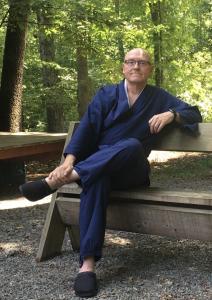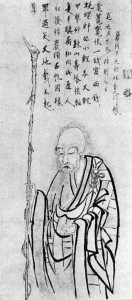Going Through the Mystery’s One Hundred Questions
My next book is cooking along and at this point it looks like it will be available in the late Fall. The book includes an introduction in which I geek out freely on the nature of Chan (Japanese, Zen) in the thirteenth century the period of transmission from China to Japan. I’ve long been interested in thirteenth century Zen because we too are a period of transmission from one culture to another. Or, we’re in the last gasps of a dying tradition – most days, it’s hard to tell.
If you are interested in the history of this period of transmission, I recommend From Chinese Chan to Japanese Zen: A Remarkable Century of Transmission and Transformation, by Steven Heine.
However, the forthcoming Going Through the Mystery is not a history, but a translation of a text from this period. It was written by Caodong (Japanese, Soto) master, Wansong (1166–1246), prompted by the one hundred questions asked by a student, Yuantong (no dates). Another Soto monk, Linquan (no dates), wrote verses for each of the Q&As. I translated the text and added commentaries, much like what I did for The Record of Empty Hall. In the later work, I translated one hundred koans that were selected by a Linji (Japanese, Rinzai) master, Xutang, and his piercing capping phrases. (1)
But I was telling you about the introduction for Going Through the Mystery’s One Hundred Questions, so I’ll now get back to that. In reworking the text, it became clear that the introduction needed to focus mostly on the figures in the text – Wansong, Yuantong, and Linquan – and only secondarily on the historical context. So I cut out a bunch of material that had lingered in the early drafts.
I think some of you might find some of what I’d written helpful, or at least interesting, especially regarding the differences between the Soto and Rinzai lineages at the point of transmission from China to Japan – and most importantly the implications that has for us today.
What I’ve found is that those differences were minimal, especially in what matters most – the actual practice and awakening of the people involved. For example, the journeys of Xutang, the Rinzai master, and Wansong, the Soto master, were very much alike. (2) Both of them had been assigned to work with key phrases from koan. Both did a lot of zazen and dug deeply into marrow of this life. Both had an initial awakening and then a deeper awakening. Both had steeped themselves fully in the practice and teaching of the Zen tradition. Both found a clear-eyed teacher who catalyzed their awakening.
In this post, I’ll go into some detail on Wansong’s awakening, highlighting how similar Soto and Rinzai teachers taught in thirteenth century China, and explain why it’s a bit more complicated than that. And in so doing, explore whether Soto and Rinzai share the same essence.
Click here to support my Zen teaching practice (of which translations and writings like this are one facet) via Patreon.
Wansong’s surprising first awakening
“The Dharma Mirror of the Ancestors, Scroll 70,” has this about Wansong’s first awakening:
“At first, Wansong practiced with Venerable Shengmo, examining Changsha’s words, ‘Turn oneself around in the mountains, rivers, and the great earth.’ After six months, Shengmo said, ‘I only wish you a late realization.’ Wansong suddenly had insight.”
This was an important initial opening and Wansong would go on to have a definitive awakening later with Xueyan Huiman (d. 1206), also a Soto master. It is notable that the Soto master Shengmo assigned the young Wansong a key phrase from a kōan, Changsha’s words, “Turn oneself around in the mountains, rivers, and the great earth,” a practice that is more associated nowadays with the Linji lineage.
The contemporary narrative about Soto Zen in this period is that the main practice was silent illumination (默照, mozhao). However, there is no support for this in Going Through the Mystery’s One Hundred Questions. The closest the text comes to silent illumination is in Question 9: How Is Thusness Meditation Practiced? However, what’s referenced in Question 9 is based on the Lankavatara Sutra, a favorite of Bodhidharma, and so it is a query that might well be common to all Zen lineages.
Silent illumination, that which was supposedly distinctive about the Soto lineage, is also absent from Wansong’s most well-known work today, “The Record of Going Easy” (available in English as The Book of Serenity), published in 1224 when Wansong was about sixty years old. In neither work do the characters for silent illumination appear even a single time. Nor, incidentally, does Dogen use the term a single time in his voluminous thirteenth century works.
Not so simple
However, the great master Hongzhi (1091-1157) did speak of silent illumination. Schlutter notes,
“The most famous text associated with silent illumination is Hongzhi’s long poem, the ‘Mozhao ming’ [translated by Taigen Leighton as ‘The Guidepost of Silent Illumination’]. This poem contains the only instance in all of [Soto] literature in which the term ‘silent illumination’ is prominently used.” (3)
Although Hongzhi used the phrase, it was his dharma brother, Zhenxie Qingliao (1089-1151), who was the direct target of the Rinzai master Dahui Zonggao’s (1089–1163) strong rebukes. For Dahui, silent illumination was a method for wallowing in tranquility and denying awakening. Zhenxie provided a clear example of such silent illumination wallowing in passages like this:
“Without taking a step you should constantly sit in your room and just forget about the teachings. Be like dry wood, or a stone, or a wall, or a piece of tile, or a pebble. Cut off knowing and understanding and be naturally vacuous and completely bright. You should not make the least bit of conscious effort.” (4)
This style of teaching only became prominent in the late eleventh and twelfth centuries, though, through Furong Daokai and some of his successors, but it seems to have disappeared by the thirteenth century.
Schlutter explains,
“Around the same time [in late eleventh century], the [Soto] tradition, one of the traditional five houses of Chan, began to undergo a momentous revival…. Having almost died out, its lineage was resurrected at the end of the eleventh century, and within decades it became one of the most powerful groups of elite monastic Buddhism in Song China. The study of this revival yields important insights into the creative process by which the [Soto] tradition was reinvented through the remaking of its lineage, the crafting of suitable hagiographies for its ancestors, and, eventually, the creation of a distinctive style of teaching and practice that came to be known as silent illumination.” (5)
However, Dahui repeatedly attacked this type of quietistic mediation. Here is one example:
“At the present time, there is a type of shaven-headed heterodox monk who, even though [their] own eye is not yet clarified, single-mindedly teaches people to stop-to-rest in the very way the gedan-beast plays dead. If you practice this sort of stopping-to-rest, by the time a thousand buddhas have appeared in this world, you still won’t have been able to stop or take a rest! You will just have made your mind more susceptible to delusive worrying.” (6)
Such attacks by Dahui, which Schlutter finds not completely fair, by the way, seem to have carried considerable weight in the Chinese Zen community across lineages. Indeed, it may be the effectiveness of Dahui’s arguments against silent illumination in the twelfth century that resulted in it’s lack of visibility in the Soto literature of the thirteenth century.
By the late twelfth and thirteenth centuries, the awakening stories of Chinese masters in both Soto and Rinzai lineages prominently include working with keywords/phrases from koan and are indistinguishable. No mention is made of silent illumination.
More differences within than between
It is clear from the historical record that there were no significant differences between the Soto and Rinzai lineages during the pivotal thirteenth century, the era of transmission from China to Japan. However, there had been differences in the twelfth century between some sublineages of Soto and the mainline of the Rinzai transmission, focussed mostly on silent illumination and the importance of an abrupt awakening experience.
Those differences appear to be mostly the result of late some twelfth and early thirteenth century Soto teachers emphasizing and renaming long-established meditation methods for absorption (aka, samadhi) as silent illumination, although those methods had long been practiced widely in the Zen tradition. Dahui criticized this emphasis as heterodox, although these Soto teachers were mostly putting old wine in new bottles. His own keyword method, on the other hand, was much more of an innovation. (7)
However, by the thirteenth century, due to the power the the keyword method and the blistering critique of the silent illumination narrative by Rinzai masters like Dahui, the Zen lineages in China had returned to their previous positions of lacking almost any distinction in teaching style or practice. Incidentally, I have argued previously that the work of Rujing and Dogen can be seen as an integration and restatement of the One School Zen. See, for example, see Just Sit or Wake Up: A Tale of Two Old Zen Teachers.
In Japan, Heine notes that successors of the Soto master Hongzhi, highlighted above for his “The Guidepost of Silent Illumination,” “… became a minor but influential wing of Rinzai Five Mountains temples located in the capital, [and] did not interact much with the main factions of the Soto sect.” (8)
This quirky detail supports my thesis that by the transmission from China to Japan in thirteenth century there were more differences within the two lineage groups – Soto and Rinzai – than between them and that most differences were due simply to the personalities of the teachers, not to their lineage affiliations. At the very least, differences in the lineage winds were complex, multidimension, subtle, and by the thirteenth century, they were not about meditation technique.
For more on why the Soto and Rinzai lineages were so similar at the point of transmission, stay tuned for my next post, “Soto Zen’s Dirty Little Secret.”
(1) In this essay, I’ll use the Japanese “Soto” and “Rinzai” for whole lineages, including the Chinese Caodong and Linji – to aid the reader. However, that isn’t to say that I assume that Caodong = Soto or that Linji = Rinzai. One led to the other, but I’m afraid we have another “same or different” issue here that is beyond the scope of this post.
(2) See The Record of Empty Hall, 4-6.
(3) Morten Schlutter, How Zen Became Zen: The Dispute over Enlightenment and the Formation of Chan Buddhism in Song-Dynasty China, 145.
(4) Ibid., 154.
(5) Ibid, 10.
(6) Jeffrey L. Broughton with Elise Yoko Watanabe, trans., The Letters of Chan Master Dahui Pujue, 3.2.
(7) See Schlutter, 172-174.
(8) Steven Heine, From Chinese Chan to Japanese Zen: A Remarkable Century of Transmission and Transformation, 129.













